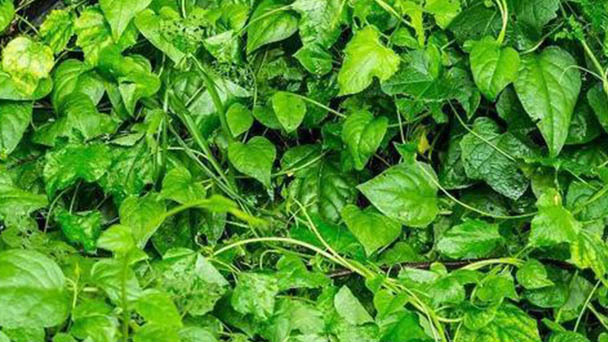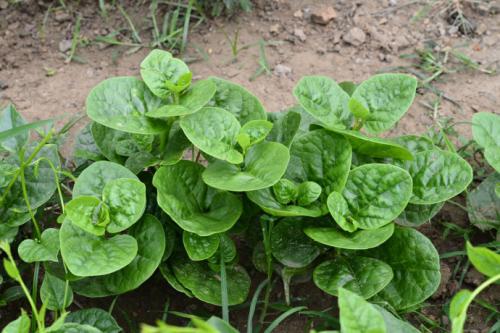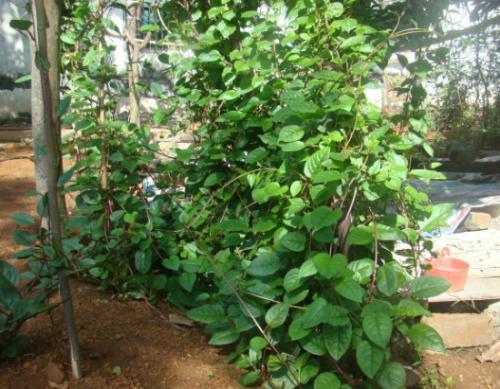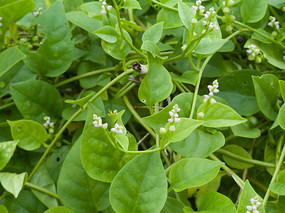Malabar spinach (Basella rubra) profile
Written by Maggie
Mar 08 2021

Malabar Spinach is an annual vine of the family Malabar Olivan. Malabar Spinach is a kind of edible vegetable. Malabar Spinach is widely distributed in China. Malabar Olive is eaten as a seedling, a young stem, and a young leaf bud. The whole plant is used medicinally.
Malabar Spinach picture

Morphological characteristics of Malabar Spinach
Stems
Malabar Spinach is an annual twining herb. Stem is several meters long, glabrous, fleshy, green or purplish red.
Leaf
Leaves of Malabar Spinach are ovate or suborbicular, 3 -- 9 cm long and 2 -- 8 cm wide, apically acuminate, base slightly cordate or orbicular, decumbent, entire, abaxially veined slightly convex; Petiole of Malabar Spinach is 1 -- 3 cm long, fluted.
Flowers
Spears of Malabar Spinach are axillary, 3 -- 15 (-20) cm long; Bracts are minute, caducous; Malabar Spinach has 2 bracteoles, calyx - shaped, oblong, persistent; Perianth segments are pale red or lavender, ovate-oblong, entire, apex obtuse, inflexed, lower part white, with a synthetic tube; Stamens are with perianth tube mouth, filaments short, base flat wide, white, anthers light yellow; Stigma of Malabar Spinach is elliptic.
Fruit
The fruit of the Malabar Spinach is globose, 5 -- 6 mm in diameter, red to dark red or black, succulent, surrounded by persistent bracteoles and perianth.
The ecological habits of the Malabar Spinach
Tolerant to high temperatures and high humidity, the Malabar Spinach grows on loose, fertile sandy loam soil. Generally, the suitable temperature for seed germination is about 25℃, and the suitable temperature for plant growth is between 25℃ and 30℃. The soil moisture is needed throughout the growth period.
Some cultivars of Malabar Spinach have strict tolerance to high temperature and short sunshine, while most cultivars have less tolerance to sunshine.
Malabar Olive is born below 2000m above sea level.
Propagation of Malabar Spinach
Usually with sowing propagation, a small number of cuttings can be propagated, plants often grow adventitious roots, cutting easy.
Sowing: spring sowing, 15 ~ 20 days after sowing, germinate neatly. Cuttage, growth period can be carried out, 10-12 days after the root.
How to grow and care for Malabar Spinach
Fertilizer
Malabar Spinach is not strict with soil. It is preferred to have a fertile, leave-rotting, acid soil, which is resistant to drought, disease and insect pests.Like fertilizer, especially like organic fertilizer;
Watering
Malabar Spinach likes moisture and hates stains. Water must be maintained throughout the growing and growing seasons, and the soil must be kept moist.
Trim
The Malabar Spinach has a particularly strong root system that grows rapidly. Growth season, can see the stem and leaves pumping long phenomenon, plant height 0.3 meters, need to build, for climbing tendril;
Repotting
If you want to plant one Malabar Spinach pot, use a larger pot and leave the harvested plants unleavened so that they can bloom and seed. Malabar Spinach can be densely planted for food and shade.

Malabar Spinach pest control:
Prevention and control of purple spot: strengthen field management, prevent stains and waterlogging, increase the application of phosphorus and potassium fertilizer to improve plant resistance. Also available is 70{BF} methyl tobuzine WP 1000 times liquid spray.
Prevent gray mold: prevent low temperature and high humidity, the onset of spray 5{BF} quickling wettable powder 1500 times liquid.
Prevention and control of grubs and aphids: prevention and control of grubs to apply decrepit coarse fertilizer, can also be used poison bait (fried wheat bran mixed with tryptrite) to kill; Can hang silver-gray film to aphid expulsion, with the yellow board that besmear has pesticide to trap kill or spray with the liquid of 2000 times of happy fruit.
Species classification of Malabar Spinach
The species of Malabar Spinach can be divided into red, white, and black, depending on the color of the flower. The first two are mainly cultivated as vegetables.
1.Red Malabar Spinach
Stem lavender to pink or green, leaves nearly equal in length and width, a few longer leaves at base of lateral branches, leaf base heart-shaped.Common cultivars are:
(1) Red Malabar affections, also known as red Malabar and red stalks of the love of the oats of the world.Stem lavender to pink, leaves dark green, veins around the purplish red.Leaf blade ovoid to suborbicular, apex obtuse or slightly indented. Leaves are small, about 6 cm long and 6 cm wide. Spicate, pedicels 3-4.5 cm long. Originally produced in India, Burma and America and other places, more varieties.
(2) Green Malabar Oils are a variety of red Malabar Oils.In addition to the green stem, other characteristics and economic traits are basically the same as red Malabar Olive.
(3) the wide-leaved Malabar, also known as the larger leaved triumph of the oats. Stem green, older stems partly or entirely pinkish to lavender. Leaves dark green, sharp tip, there are more obvious concave. Leaf blade heart-shaped, sharply concave at base, extending downward to petiole, with deep and distinct grooves. The leaf type is broad, with the average length of 10 ~ 15 cm and width of 8 ~ 12 cm. Spicate, pedicels 8-14 cm long.Native to tropical Asia and Hainan, China. Guangdong and other places. There are many varieties, such as Guiyang Malabar Olive, Jiangkou Malabar Olive, etc.
2.White Malabar Spinach
Also known as white Malabar or fine leaf Malabar. Stem light green, leaves green, leaf blade ovoid to oblong-ovate-lanceolate, base rounded or acuminate, apex acute or slightly obtuse, margin slightly undulate. Its leaves are the smallest, averaging 2.5 ~ 3 cm long and 1.5 ~ 2 cm wide.Spicate with a longer pedicel, sparsely flowers.Native to tropical Asia.
The distribution of the Malabar Spinach
The Malabar Spinach is native to tropical Asia (southern China, India, etc.). It is now grown in Asia, Africa and the Americas. China to the south of the Yangtze River basin cultivation more, in recent years as a special introduction to the north, in the country generally planted.
Malabar Spinach is cultivated in Africa and the Americas. China has a long history of cultivation, with the first recorded mention of Malabar triumph in 300 BC. At present, there are more cultivated in the southern provinces of China, and there are also cultivated in the north, which has been listed as rare and special vegetables.
Malabar Spinach main uses
Medicinal value
Malabar Spinach is used as a laxative. It can smooth the intestines, dissipate heat, and relieve urine and defecation. The flower juice has the clear blood detoxification effect, can solve the pox poison, the external application cures carbuncle poison and the nipple rupture.
Landscape use of Malabar Spinach
Malabar Spinach is a lovely vine with purplish red stems and leaves, pale red flowers and purplish black fruit. It is used for landscaping courtyards, windowsills, and small fences.

Latest Updated
- Benefits of Bugleweed - 7 Science-backed Health Benefits
- Bugleweed Dangers & Side Effects - Is It Poisonous?
- How to Plant Evergreen Trees - What You Should Know
- When to Plant Evergreens - Grow Guide for Evergreen Trees
- 12 Wonderful Evergreen Shrubs for Your Garden
- 12 Popular Evergreen Plants with Pictures for Beginners
- When And How To Prune A Lilac Bush Like a Pro
- How to Grow & Care for Lilac Vine (Hardenbergia Violacea)
- Japanese Lilac Tree (Syringa Reticulata) Care & Propagation Guide
- Shumard Oak Pros and Cons - What to Know
Popular Articles
- Winter maintenance of Antirrhinum Majus
- How to Grow Terminalia Mantaly Tree
- How to Grow and Care for Crossostephium Chinense
- How to grow Antirrhinum Majus in spring
- Peristeria Elata (Dove Orchid) Profile: Info & Care Guide
- Underwatered Snake Plant (Sansevieria Trifasciata) - Signs And How To Fix
- How to Care for Brazilian Jasmine Plant (Mandevilla Sanderi)
- How to Grow & Care for Graptopetalum Purple Delight in Summer
- Rosa Chinensis (China Rose): Plant Growing & Care Tips
- How to Care for Baby Sun Rose (Aptenia Cordifolia)